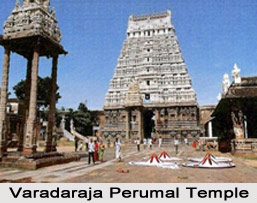 Varadaraja Swami temple is situated at Kanchipuram, approximately 75 km from Chennai. It covers almost miles of landscapes of the town. The origin of this temple can be traced back to the 6th century AD. This temple is dedicated to Lord Vishnu and is one of the largest temples in Kanchi and in the whole of India. The centre of attraction in Vishnu Kanchi is the Sri Varadaraja Perumal Temple situated on the top of Hastigiri or Elephant Hill. One has to ascend 24 steps up the hill to reach the sanctum sanctorum. Lord Varadaraja is in a standing posture facing towards the west with his gracious look. The figure is huge in size with four hands holding the insignias of Sankha, Chakra, etc., and richly decorated with costly jewels.
Varadaraja Swami temple is situated at Kanchipuram, approximately 75 km from Chennai. It covers almost miles of landscapes of the town. The origin of this temple can be traced back to the 6th century AD. This temple is dedicated to Lord Vishnu and is one of the largest temples in Kanchi and in the whole of India. The centre of attraction in Vishnu Kanchi is the Sri Varadaraja Perumal Temple situated on the top of Hastigiri or Elephant Hill. One has to ascend 24 steps up the hill to reach the sanctum sanctorum. Lord Varadaraja is in a standing posture facing towards the west with his gracious look. The figure is huge in size with four hands holding the insignias of Sankha, Chakra, etc., and richly decorated with costly jewels.
The legend associated with Sri Varadaraja Perumal Temple says that according to the Brahmanda Purana once entire creation had come to a standstill because of the pollution of the mind of Lord Brahma, the Creator. To get rid of this mental pollution he entered into deep meditation on the banks of the holy Ganga to purify himself. An invisible voice was heard by him wherein he was directed to perform one thousand yagnas to bring purity to his mind. As the number was overwhelming for him to perform during a lifetime, he intelligently selected Satyavrata Kshetram as the most sacred place where performance of one yagna gets the merit of a thousand.
Brahma had previously got into an altercation and misunderstanding with his consort Saraswati. Finding Brahma engaged in celebrating a sacrifice, Goddess Saraswati wanted to spoil its merits by washing away the sacrificial area, and transformed herself into the form of River Vegavati. Brahma started fervently praying to Lord Vishnu to save him from this predicament by arresting the flow of the river. Mahavishnu came in the form Yathoktakari Perumal and laid himself flat against the course of the fast-flowing river. Just then Brahma concluded his yagna and Mahavishnu emerged out in the form of Varadarajaswami. Brahma requested him to bless his devotees for all time to come at this place and Mahavishnu conceded to his request and remained manifested there in physical form. It is believed that Mahavishnu appeared to Brahma in Krita Yuga, to Brihaspati in Dwapara Yuga and to Adhi Sesha in Kali Yuga.
As far as the architecture of the temple is concerned it can be said that is an artistic marvel. The temple was built by the rulers of Vijayanagara rulers and it covers an area of 23 acres all together. Even the sculptural beauty of the temple is wonderful. The Sri Varadaraja Perumal Temple stands as one of the 108 holy Vaishanavite shrines of the country. Over the ages the temple has been all the more beautified by the Pallava and the Chola Rulers. The Varadaraja Swami temple has now become a veritable treasure house of iconography with its several sculptures of different deities and other sculptures of gypsies, jesters, flora and fauna. The temple chariot of the Varadaraja Swami Temple of Kanchipuram is regarded as one of the largest in South India.
The Varadaraja Swami Temple contains three sacred places of Puranic importance, first the shrine of the presiding deity Lord Vardaraja, the second, and the shrine of Lord Yoga Narasimhaswami in the cave below Hasatgiri Hill and the third, the shrine of Sri Perundevi Tayar, consort of Lord Varadaraja.
The Tatacharyas connected with this temple were very orthodox in the observance of religious rites and rituals to their meticulous perfection as prescribed in the scriptures. The same system of religious observance has been handed down to their posterity and is still observed. The Brahmotsava with its chief item the Garudotsavam, which takes place in May-June every year, attracts lakhs of devotees from all corners of the country. The Vijayanagar kings made princely endowments and gifts of villages and jewellery to the temple.
Thus it can be concluded saying that Sri Varadaraja Perumal Temple of Kanchipuram is a torch bearer in the sage of its several marvellous temples. Thousands of art lovers and history and cultural lovers from India and all over the world come here to see the treasures in stone of the Varadaraja Swami Temple of Kanchipuram.





















